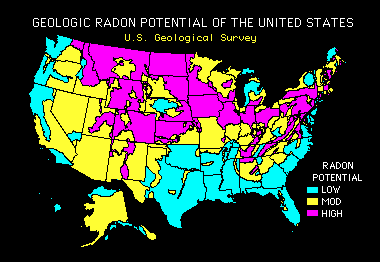Radon is a naturally occurring radioactive element found in most groundwater. It occurs more heavily in some areas than others.

Radon is measured in picocuries per liter and written as (pCi/L). One picocurie is one-trillionth of 37 billion disintegrations per second. One curie, named for Marie Curie, the discoverer of metallic radium, is the amount of radiation given off by one gram of radium.
Radon causes an estimated 14,000 lung cancer deaths each year. It is the earth's only naturally produced radioactive gas and comes from the breakdown of uranium in soil, rock, and water. You cannot see or smell radon, but it can become a health hazard when it accumulates indoors. It can enter your home through cracks and openings in the foundation floor and walls. When radon decays and is inhaled into the lungs, it releases energy that can damage the DNA in sensitive lung tissue and cause cancer.
Radon is a gas produced by the radioactive decay of the element radium. Radioactive decay is a natural, spontaneous process in which an atom of one element decays or breaks down to form another element by losing atomic particles (protons, neutrons, or electrons). When solid radium decays to form radon gas, it loses two protons and two neutrons. These two protons and two neutrons are called an alpha particle, which is a type of radiation. The elements that produce radiation are called radioactive. Radon itself is radioactive because it also decays, losing an alpha particle and forming the element polonium.
Elements that are naturally radioactive include uranium, thorium, carbon, and potassium, as well as radon and radium. Uranium is the first element in a long series of decay that produces radium and radon. Uranium is referred to as the parent element, and radium and radon are called daughters. Radium and radon also form daughter elements as they decay.
The decay of each radioactive element occurs at a very specific rate. How fast an element decays is measured in terms of the element "half-life", or the amount of time for one half of a given amount of the element to decay. Uranium has a half-life of 4.4 billion years, so a 4.4-billion-year-old rock has only half of the uranium with which it started. The half-life of radon is only 3.8 days. If a jar was filled with radon, in 3.8 days only half of the radon would be left. But the newly made daughter products of radon would also be in the jar, including polonium, bismuth, and lead . Polunium is also radioactive - it is this element, which is produced by radon in the air and in people's lungs, that can hurt lung tissue and cause lung cancer.
Health Effects
Drinking water that contains radon is not believed to cause a significant health risk, but a high airborne radon level is linked to increased risk of lung cancer.
Approximately one out of every 10 homes in some states has an airborne radon level above 4 pCi/L. Radon in water contributes to the airborne radon level in some of these homes, adding to the airborne radon that enters the house as a soil gas. Over a long period, airborne levels of radon above 4 pCi/L may increase your family's risk of lung cancer.
Treatment
Good ventilation of bathroom, laundry, and kitchen areas may be enough to prevent the buildup of airborne radon coming from water.
If this is not effective, consider a granular activated carbon filtration system or an aeration system.
Granular activated carbon (GAC) filter systems have been very effective at lowering water- borne radon levels, but the radioactivity that builds up in the filter bed may be of some concern. Install GAC systems only outside of your home.
Aeration systems are also effective and do not accumulate radioactivity. Aeration systems mix the water with air in an outside-vented chamber. After aeration, the water is piped into the house free of radon. Aeration systems require periodic cleaning to remove particulates that come from minerals in the water.
Radon can be removed from water by using one of two methods: aeration treatment or granular activated carbon (GAC) treatment.
Aeration treatment involves spraying water or mixing it with air, and then venting the air from the water before use.
GAC treatment filters water through carbon. Radon attaches to the carbon and leaves the water free of radon. The carbon may need special handling in its disposal if it is used at a high radon level or if it has been used for a long time.
In either treatment, it is important to treat the water where it enters your home (point-of-entry device) so that all the water will be treated.
Point-of-use devices, such as those installed on a tap or under the sink, will only treat a small portion of your water and are not effective in reducing radon in your water. It is important to maintain home water treatment units properly because failure to do so can lead to other water contamination problems.
When radon is adsorbed on GAC, it decays with a half-life of 3.8 days to produce a series of radioactive decay products. The first 4 decay products of radon have short half-lives of less than 30 minutes. The fifth decay product in this series is 210/Pb which has a half-life of 22 years. The build-up of 210/Pb could require the GAC to be disposed of as radioactive waste.
At the present, there are no federal regulations specifically applicable to the disposal of GAC containing natural radionuclides. EPA is currently considering the development of regulations controlling the disposal of waste containing naturally occurring radionuclides in excess of a concentration of 2,000 pCi/g. EPA has also recently published "suggested guidelines" for the disposal of naturally occurring radionuclides generated by drinking water treatment plants that recommend restrictions on disposal of waste with substantially lower concentrations of 210/Pb.
See also:
http://www.purewaterproducts.com/strippersandradon.htm for more information about radon removal. |